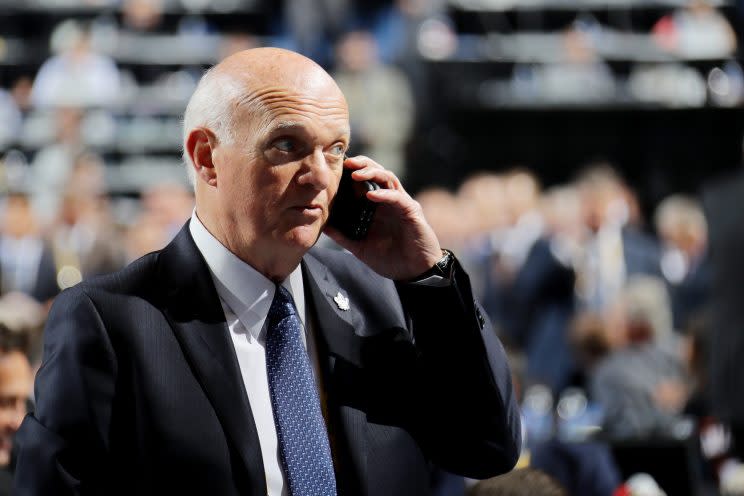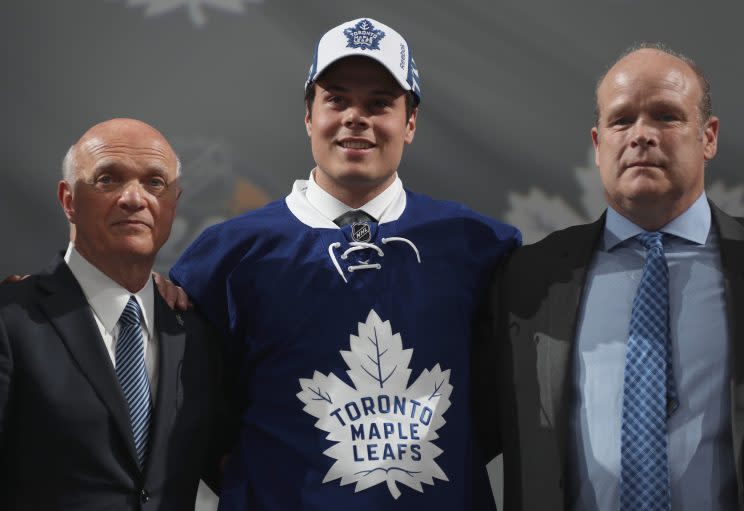Lou Lamoriello and Maple Leafs: 5 things we’ve learned after a year

I’m sitting at the same table that I was one year ago, laptop next to coffee mug, early hours of a summer morning. Except this time, as I write about Lou Lamoriello, there’s considerably less shock, awe, Eastern Conference plate tectonics and bafflement.
Growing up as a New Jersey Devils fan, imagining that Lamoriello would leave the general manager’s chair wasn’t too outrageous. We all get old. We ride off into the sunset, content that we’ve left a legacy behind, which in his case was three Stanley Cups, five conference titles, and the basic survival of the franchise through frequency of playoff appearances. Not too shabby.
What I never imagined was seeing Lamoriello step down from the Devils to become another NHL team’s general manager. Sure, he could slide into some NCAA front office or USA Hockey role. That made sense. But seeing Lamoriello running another franchise was like seeing your franchise player wearing another sweater before retirement.
So the question is, after one year as the Toronto Maple Leafs’ general manager: Is he Ray Boruque with the Avalanche, or Mike Modano with the Red Wings?
When Lamoriello was hired, I asked five vital questions about his taking over the Leafs.
Here’s how we’d answer them after his first year at the helm.
Is Lou ready to be less important than his coach?
It appears so, although it’s not like there’s been any reason for Babcock to pull a power play yet.
Mike Babcock has an eight-year contract with the Toronto Maple Leafs worth a reported $50 million. Lou Lamoriello has a 3-year deal. There’s no question who runs the yard here – it’s Brendan Shanahan – but one imagines Babcock would win any power struggle, just given the investment.
What we’ve learned is that he won’t have to. The cohesion on the managerial side of the Maple Leafs has been impressive thus far, given the three huge personalities that are working together in Babcock, Lamoriello and Shanahan. They were on the same page for the tank, and appear to be working well in player acquisitions. (Sorta … more on that in a second.)
A coach doesn’t exactly have much sway when the team sucks, but the minute the Leafs turn the corner it’s going to be cemented as Babcock’s success. Yet we’re more confident now that Lamoriello is content to be, for the first time in his career, less important than his coach.
Which must be weird, considering he used to go through coaches like most of us go through coffee filters.
Will Emperor Lamoriello be one of many voices?
Yes.
Well, maybe.
Lamoriello’s biggest impact in the last year was in bringing some of his more … “thrifty” traditions to Toronto. Like his battle with Bell and Rogers over travel costs for television and radio talent, barring them from the team charter. It was classic Lou, and true to form, he won the battle.
But he’s also worked hard to change the culture in Toronto, bringing a refreshing candor to interactions with players while closing up leaks to the media, which is a feat more impressive in Toronto than Newark.
Shanahan’s built a hell of a braintrust: Lamoriello, Babcock, young GM-in-waiting and minor league architect Kyle Dubas, director of player personnel Mark Hunter and cap guru Brandon Pridham. Lamoriello, as the general manager, is at the top of the food chain, but it’s clear there are many voices invited into influencing the team’s decisions.
Which is why is was curious to see some of the moves the Leafs made in this offseason. Which brings us to …

Can an old dog learn new math?
The Frederik Andersen trade-and-sign gave the Leafs a starting goalie with limited experience. The Matt Martin signing was one that spoke to ‘grit and character’ more than any analytic argument for why it should have been made.
Those moves, and a draft class that veered older and bigger, gave James Mirtle pause:
None of it fits the profile of a new-age front office – but then again, the Leafs are a hybrid. They have a lot of different voices advocating different things, presumably with president Brendan Shanahan serving as the final referee. It stands to reason that it was the older-school types, as in Lamoriello, who wanted this fledgling team to be bigger, grittier and have more character.
It’s plausible that adding Andersen was owing to head coach Mike Babcock’s desire for the team to win more games in the near term. What will be fascinating is which voices win out as Toronto moves into Stage 2 of its rebuild, beginning the complicated process of filling in more talent around the kids.
Do they stick with a pure-skill model, with an assist from the analytics department, the way that assistant GM Kyle Dubas did in building his successful junior team, the Sault Ste. Marie Greyhounds, and the AHL-leading Toronto Marlies?
Do they look more like the post-championship Detroit Red Wings, who had plenty of veterans and grinders in key roles, in deference to Babcock, who was heavily in favour of adding Martin? Or is this simply Lou’s roster according to Lou’s rules, the same rules that turned the New Jersey Devils into the mess they were by the time he left town?
All good questions, and they all speak to how much influence Lamoriello has in making this team in the image of his previous successes.
Were the Devils’ finances to blame for Lamoriello’s demise?
This question was a bit more about the Devils than it was about the Leafs, but we’ve learned a little about both through the year.
Keep in mind that while Lamoriello fought to keep payroll down and keep the cap hits for veteran players reasonable, he was able to have a robust payroll for most of his time in New Jersey.
But when Lamoriello left the Devils, he claimed the new ownership’s spend-thrifty approach derailed the team. “You weren’t allowed to do some of the things for financial reasons, to be perfectly honest. It really started to change a little,” he said.
The evidence is clear that the Devils are a budget team at the moment, with the third-lowest amount in total salaries in the League (per General Fanager) at $59.4 million. They’re around $5.8 million over the cap floor.
As for Lamoriello, he said that freed from those financial constraints, he’s able to approach his job in a different way. From Sportsnet, on the Auston Matthews signing:
Lamoriello may strive to create an organizational culture where the focus is entirely on the collective, but he’s also aware of what Matthews represents to the Leafs. Of what he might be capable.
In that light, his long-standing business policies include a little wiggle room for exceptions. The veteran GM says he’s not doing things the “New Jersey way” any longer.
Of course, when you’re rebuilding, there aren’t too many contract wars to wage. Yet.
Finally …
Has Lamoriello lost it?
We asked it when he was hired by the Leafs, and we’re going to go ahead and say “no.”
This isn’t strictly an assessment of his on-ice decisions, because it’s easy to knock down the walls but harder to build a better house. How the Leafs surround their young core will ultimately determine Lamoriello’s player evaluation effectiveness, which honestly has earned the skepticism it’s gotten after some antiquated decisions with the Devils.
But where Lou is clearly still Lou is in creating a culture within a team.
The Leafs didn’t have anything close to standards of discipline and excellence when he arrived, and Lamoriello’s instilled both. It’s easy to forget that we’re only a dozen months removed from jerseys being thrown on the ice in protest and an adversarial relationship with the media that became simply toxic. It’s easy to ignore the strides Lamoriello’s made in bringing respect back to the organization, as it undertakes this rebuild with the confidence of fans that the adults are indeed in charge. Some of this is accomplished simply by being Lou Lamoriello.
Shanahan is fond of the symbolism we saw when Bill Daly revealed Toronto had won the draft lottery – with a revamped team logo, he literally turned over a New Leaf.
And they do feel like the new Leafs in the past year. Even if at the heart of that reversal is an old GM.
—
Greg Wyshynski is a writer for Yahoo Sports. Contact him at puckdaddyblog@yahoo.com or find him on Twitter. His book, TAKE YOUR EYE OFF THE PUCK, is available on Amazon and wherever books are sold.

 Yahoo Sports
Yahoo Sports 

